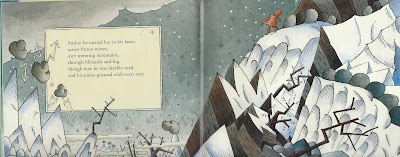This post continues my series about creating a children’s picture book illustration portfolio. First I covered
quantity and quality and then I covered
format and content. In this post I dig deeper into content and suggest some tips and tools for improving your work, I start by showing the new work I have added to my portfolio (if you just want the tips scroll down to the end of this post):
 |
| "The Four Seater", Gouache by Claire O'Brien |
 |
| "Laughter in the Leaves" Ink by Claire O'Brien |
 |
| "Boy at the Computer" Pencil by Claire O'Brien |
 |
"Horsebox" Ink by Claire O'Brien
|
In previous posts I established that my aims are to:
- Produce work in a landscape format.
- Produce consistent looking sequential images that feature characters doing different actions and showing different emotions.
- Include more settings/backgrounds (move away from white backgrounds)
I have removed “When Mum Came Back” because it is in portrait format and on a white background. I have removed Jack Frost as, though it has a background, it is in portrait format and is too ‘Fantasy’ to stay (I may remake this image one day, as I would like to try and the capture a winter scene and the Jack Frost character more successfully and in a children’s picture book style).
 |
| “When Mum Came Back” Gouache by Claire O'Brien |
 |
"Jack Frost" Ink and Watercolour by Claire O'Brien
|
As a result of these changes, I have increased the quantity of my portfolio from six images to eight and hopefully raised the quality too. The majority of the images are in landscape format now but I must aim for all of them to be. The new illustrations don’t add enough action, the dogs in the horse box, the family on the sofa and the boy at the desk are all at static and at rest really. Only the girls laughing in the leaves are mid-action. I’m not sure if I have successfully shown different emotion yet too with the new work, there is joy in the girls in the leaves and tiredness of the family on the sofa but neither of these are sequential which help show a change in their emotions. Unfortunately there are no background settings in the new pictures so I have actually added more white space!
 |
| My Portfolio at a Glance by Claire O'Brien |
What tips will help me, and you, improve our portfolios? Here are three suggestions:
Make Lots of Work!
The more work you make, the more chances you’ll have of increasing the size and quality of your portfolio. If the standard of your work is not yet portfolio-ready, making lots of work gets the bad stuff out, as Disney animator and drawing teacher, Walt Stanchfield said:
“We all have 10,000 bad drawings in us. The sooner we get them out the better”.
Making lots of work helps you practice your craft, you can only improve! If you are stuck with what to make work about, draw from life so you do not rely on your style and what you think things look like, again this can only improve your work.
Look At The Best Work Currently Being Published!
Analyse what the illustrators and designers are doing in a children's picture book spread so that you can emulate it in your own work. Look at the backgrounds, are the characters in white space or in a fully illustrated setting? What sort of settings come up a lot? Where are the characters placed in the spread? Does it change depending on viewpoint? Long shots, closeups, bird’s eye views, etc. What are the characters doing? What do their poses, gestures and movement directions show us about what is happening in the story? Does the character’s pose and expression convey an emotion? Does the lighting echo the emotion, add to the mood? Where has the illustrator left space for the text? Is it a white space or a quiet part of the illustration? Is the illustration in duet with the text, showing what the text says or is it counterpoint and saying something different?
Evaluate And Be Critical About Your Own Work!
Look at your work as a whole, add all of your portfolio images into one document and look at them on the screen or in a print out. What stands out? Is it for good reasons or bad? What similarities are there? Look at the viewpoints you have used, where is your camera? Is it always close, far away, straight on?. What are your backgrounds like? Non existent like mine or fully realised? Do you always use the same colour palette? Is it always saturated or muted? Do your characters always face the front or the side but never anywhere in-between? Are they always making the same pose or expression? Do your characters look different to each other? Are they the same gender or age? If all these things are similar, draw them differently to show variety and skill in your work.
Well, I still feel my portfolio does not quite fit the bill of a children’s picture book portfolio yet. I’m going to follow my own tips and really focus on creating sequential images that feature characters doing different actions and showing different emotions in a background! I’m also going to start a series of monthly posts called “Spread of Wonder” where I’ll present an example of a published children’s picture book spread that I admire and tell you why I think it is so great, follow my blog so that you get a notification of when I post it. And if you are stuck for what to actually draw check out these
great suggestions from
Robin Rosenthal.


































